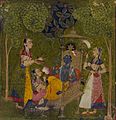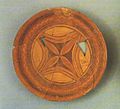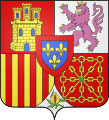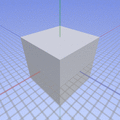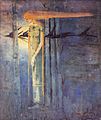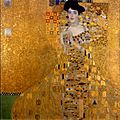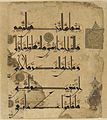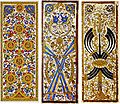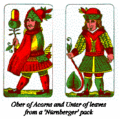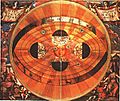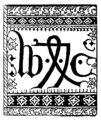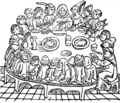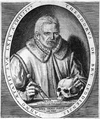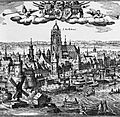History of graphic design facts for kids
Graphics are visual designs you see on surfaces like walls, paper, computer screens, or stone. This includes everything from signs, charts, and logos to drawings and geometric patterns.
Graphic design is the art of mixing text and pictures. It's used in art, ads, books, and websites. The main goal of graphics is to share information, create a brand, or make people feel a certain way.
Contents
- The Story of Graphics
- Calligraphy and Book Graphics
- Graphic Designs in Asia
- Decorative Graphics on Pottery
- The Start of Modern Graphic Design
- Mondrian's Simple Art Revolution
- Communicating with Pictures
- Information Signs: Isotype and the Viennese Method
- Dynamic Designs and Computer Animation
- Placards and Posters
- Art Nouveau Posters and Art's Influence
- Posters After World War II
- Graphic Design in Modern Life
- Images for kids
The Story of Graphics
Graphics have been around for a very long time! Early humans made amazing drawings of animals in caves. For example, in Chauvet Cave in France, there are drawings from about 30,000 BC. Similar art is found in the Lascaux cave, also in France, from around 14,000 BC.
Rock art by ancient hunters in Bhimbetka, India, is even older than 7000 BC. And Aboriginal rock art in Kakadu National Park, Australia, shows how widespread this ancient art form was. These early drawings, along with the invention of writing (around 3000–4000 BC), are the very beginning of graphic art.
Cave and Rock Art
The Start of Writing
Calligraphy and Book Graphics
Religious books often used a lot of graphics. For example, Bibles made in monasteries in Ireland, Scotland, and England were beautifully decorated. These books featured swirling patterns and small figures. This style came from old graphic traditions in the British Isles. From the 6th century onwards, these designs were used to decorate important gospel books.
-
A page from the Lindisfarne Bible, 7th or 8th century.
-
A graphic design from the Lichfield gospel, 8th century.
-
A graphic design from the Book of Kells, 6th–9th century.
-
Calligraphy came to Japan from China around the 3rd century BC. Japanese artists used it to write haiku poems.
Graphics in the Quran
In Islamic countries, beautiful graphic designs are found in their holy book, the Quran. The first Qurans were written in an angled style called Kufi, popular from the 8th to 10th centuries. Later, decorations were added to the margins and pages to make the book even more beautiful. In the 12th century, a new curvy style called Naskh was invented, and other styles followed.
Graphics and Miniatures
Graphic Designs in Asia
-
An 18th-century wood print by Japanese artist Toshusai Sharaku. Japanese wood prints influenced modern poster design.
Decorative Graphics on Pottery
For thousands of years, graphic design has been used to decorate pottery and ceramics.
The Start of Modern Graphic Design
William Morris was a big influence on modern graphics in the late 1800s. His Kelmscott Press made many beautiful graphic designs. This created a market for collecting such art. Morris and artists like Burne-Jones and Dante Gabriel Rossetti formed the Pre-Raphaelites group. Their ideas greatly shaped modern graphic design.
-
A book of poetry by Omar Khayyam, with calligraphy and design by Morris, and paintings by Edward Burne-Jones.
Mondrian's Simple Art Revolution
The Dutch painter Piet Mondrian started a new style called minimalism in painting around 1920-1921. He used simple geometric shapes and only three basic colors: blue, yellow, and red, along with black and white. This opened up new possibilities for graphic designers.
Mondrian showed that by just moving these colors around and changing the size of squares, you could create very different moods and feelings. For graphic designers who want to send a clear message without extra distractions, his minimalist experiments were a great inspiration.
Communicating with Pictures
Logos and Trademarks
A trademark (shown with ™ or ®) is a special sign or symbol. Companies use it to identify their products or services and show they are different from others. A trademark can be a name, word, phrase, logo, symbol, or a design. It's a type of intellectual property.
-
The Coca-Cola logotype was designed by Frank Mason Robinson in 1885. It has been around for over a century, building customer loyalty.
Signs of Culture and Peace
-
The flag of the Olympic Games, designed by Pierre de Coubertin. The linked rings represent the five continents, and the six colors come from national flags.
Information Signs: Isotype and the Viennese Method
In 1921, Otto Neurath, an Austrian social scientist, started using graphic design to help people understand social and economic data. By 1925, the Museum of Economy and Society used these graphics for the public. This style was called the Viennese method, but now it's known as Isotype charts.
-
A typical Isotype chart showing social statistics.
-
Pages from Basic by Isotype by Otto Neurath, 1937. It used graphics for Basic English words.
Dynamic Designs and Computer Animation
-
This animation was made from photos taken by Eadweard Muybridge in 1887.
Placards and Posters
Placards and posters have existed since ancient times. The Greek axons and Roman Albums were like early posters, with decorations and announcements. In ancient Greece, names of athletes and game schedules were written on columns that spun around. Romans used white walls in their markets where sellers advertised their products and added designs to attract customers.
The invention of printing in 1440, and especially the lithographic process invented by Alois Senefelder in 1798, made it easier to create posters. Before this, handmade posters were mainly for government announcements. William Caxton, who started a printing company in England in 1477, made the first printed poster. By 1870, advertising posters became very common.
Art Nouveau Posters and Art's Influence
-
The English artist Aubrey Beardsley created very decorative posters with flowing lines and tall figures.
-
Alphonse Mucha designed posters with elegant young women surrounded by decorative flowers, using soft pastel colors.
-
Graphic design influenced paintings by Art Nouveau artists like Margaret MacDonald Mackintosh and her brother Frances Macdonald.
-
The works of Gustav Klimt show how graphic design influenced painting, like in his "Portrait of Adele Bloch-Bauer."
Posters After World War II
After World War II, new color printing and computers changed posters a lot. People can now create colorful posters on their laptops and print them cheaply. However, very fancy printing is still expensive, often used by governments or big companies.
With the internet, posters are less important for sharing information. But some artists still use special printing methods to create art prints. This has made the difference between painting and printmaking much smaller.
-
This political poster about Ulster is a low-cost, effective design using only a few basic colors.
-
A magazine cover from a poster by Guity Novin. The artist uses only two colors (orange and green) on a yellow background.
Graphic Design in Modern Life
Today, graphic design is everywhere in modern life. It has especially influenced modern architecture.
-
Robert Smithson's Spiral Jetty (1970) on the Great Salt Lake in Utah. He used black basalt and earth to make a 1,500-foot-long design.
Images for kids
-
The opening page of the Book of Durrow, 7th century.
-
Card designs from the Mamluk Sultanate of Egypt, around 1500. Islamic playing cards used suits like coins, cups, swords, and polo sticks.
-
An astronomical map of the sky drawn by Nicolaus Copernicus in 1543. It replaced an earlier chart that showed an Earth-centered universe.
-
Theodor de Bry (1528–1598) was an engraver, goldsmith, and editor.
-
Albrecht Dürer, "St Jerome in his study" (1514). Dürer was a German painter and printmaker.
-
"Ecce Homo," an engraving from the 15th century by Martin Schongauer. He was an important German printmaker before Dürer.
-
Matthäus Merian, "View of Frankfurt," between 1612 and 1619. Merian was a famous Swiss engraver.






















